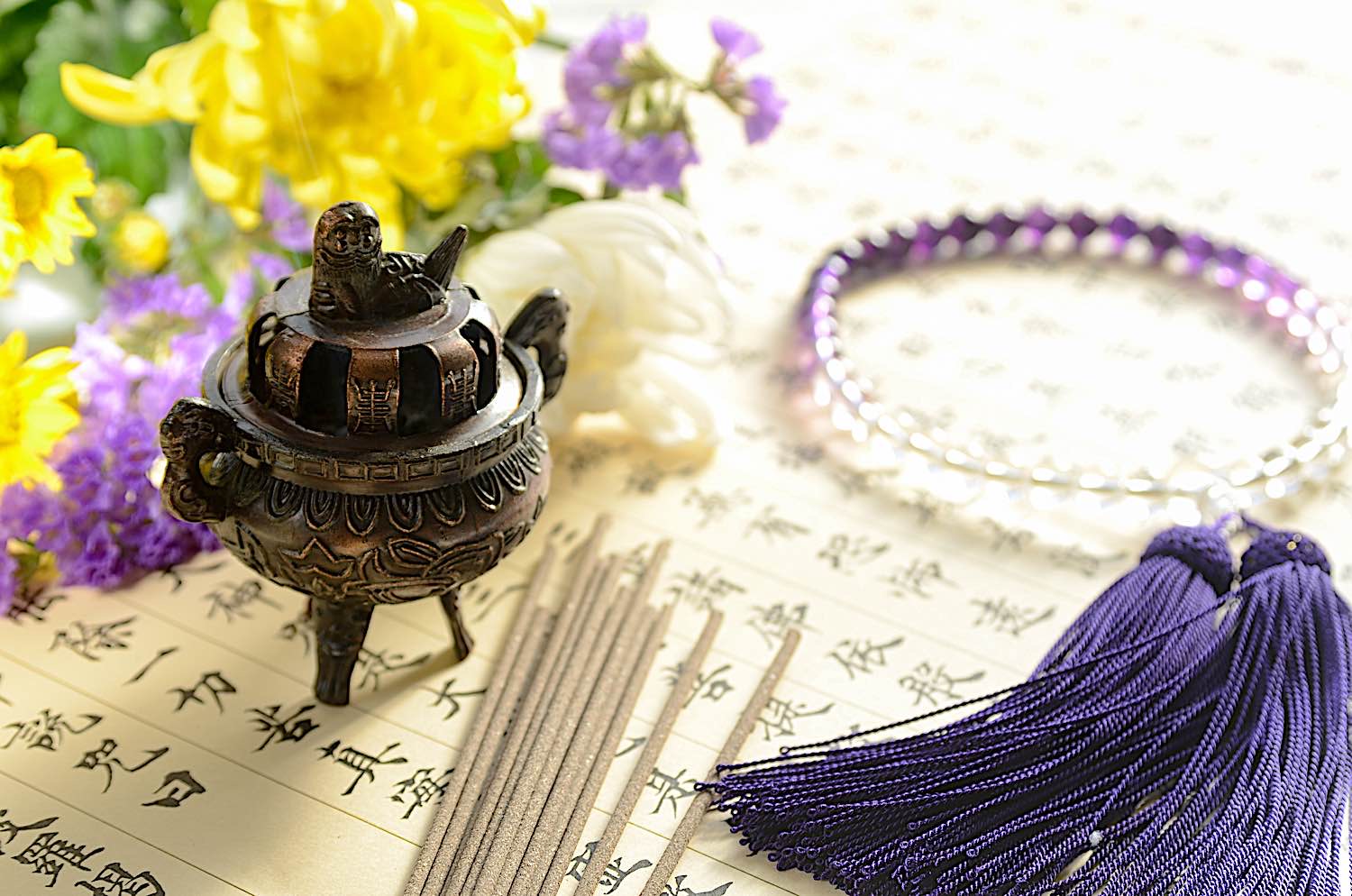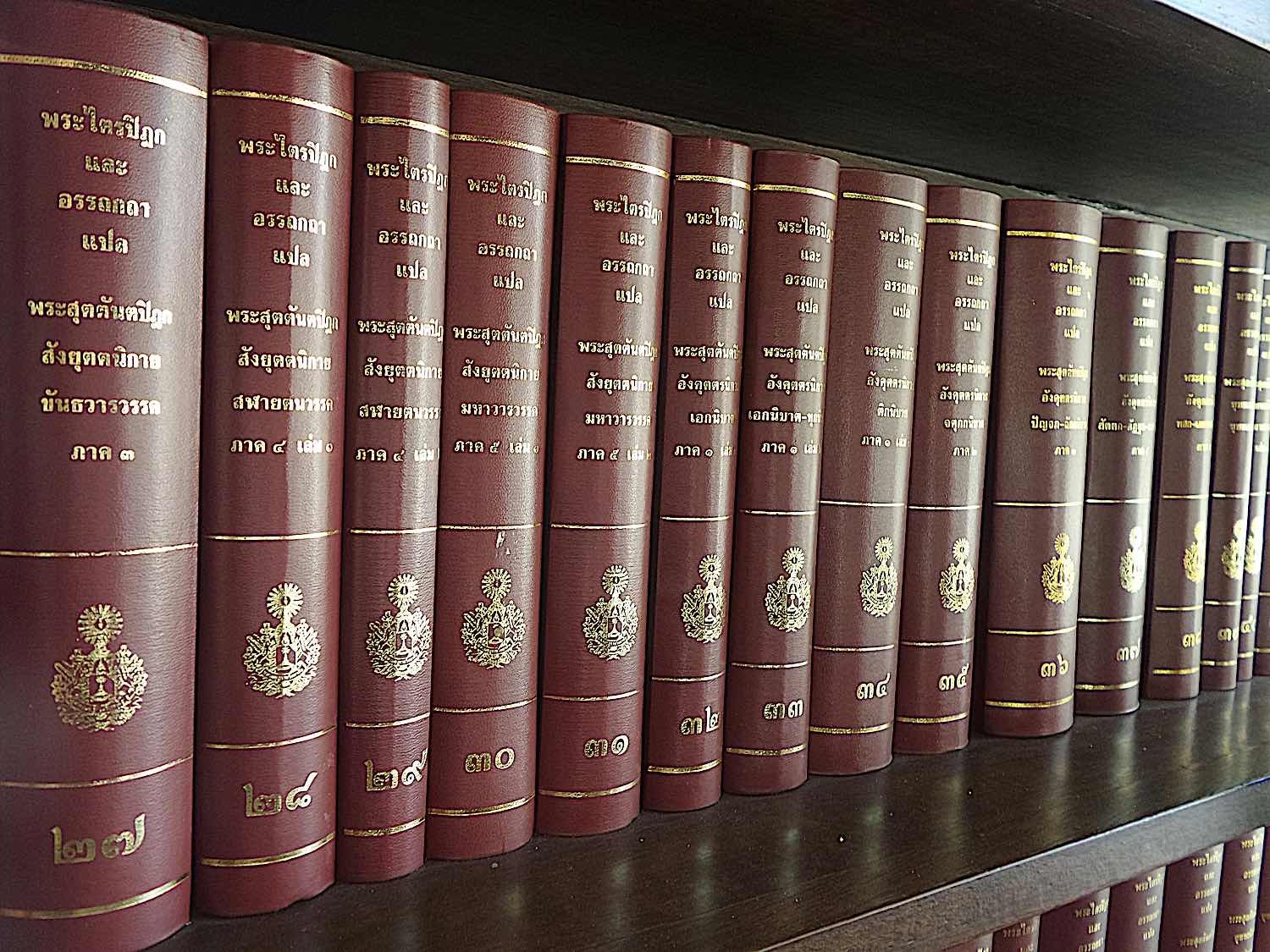Sutras: Seven Benefits of Reading Sutra Daily; and 10 Ways to Learn More and “Deep Dive” into Buddhist Sutras
Over 2,500 years ago, Siddhartha Gautama had a series of profound realizations that led him to become the Buddha, the Awakened One. In order to share his insights and knowledge with others, he began teaching and giving lectures, which...

Over 2,500 years ago, Siddhartha Gautama had a series of profound realizations that led him to become the Buddha, the Awakened One. In order to share his insights and knowledge with others, he began teaching and giving lectures, which were eventually compiled into texts called Sutras or Sutta (in Pali).
Today, Sutras remain an essential part of the Buddhist tradition and are studied by laypeople, yogis, yoginis, and monks alike. Reading, or reciting sutras, is considered an essential practice in all traditions. However, the idea of reading Sutras can be daunting for many people. After all, they were written over two millennia ago and often contained deep, complex concepts.
 A Burmese monk chanting Sutras. Reciting sutras or simply reading them is a core daily practice in most traditions of Buddhism.
A Burmese monk chanting Sutras. Reciting sutras or simply reading them is a core daily practice in most traditions of Buddhism.
Whether you’re a beginner or have been studying Buddhism for years, reading Sutras offers many ways to enjoy and learn. Today, we’ll explore ten helpful tips to make studying Sutras more enjoyable and enlightening.
For a feature on the benefits or reciting Sutras/Suttas out loud, see>> For our special section with many English-translated Sutras/Sutras, see>> Monks studying by candlelight.
Monks studying by candlelight.
Why read Sutras?
Motivation for anything we do is key to maintaining interest and focus. When it comes to reading Sutras, it can be helpful to reflect on why we want to engage with this ancient wisdom text in the first place. If we can keep our goals and motivations in mind, it’ll be easier to stay on track when we’re feeling bogged down by the details.
According to Master Sheng Yen of Dharama Drum Mountain, the benefits of reading sutras include: illuminating the mind, comprehending the teachings, cultivating concentration, propagating the Dharma, protecting the Dharma, delivering the deceased, and praying for blessings.
 Reading sutras daily is an essential practice in Buddhism — although it can be helpful and enjoyable to study sutra in a group — either organized by your local Buddhist group, or online, or even informally organized by friends.
Reading sutras daily is an essential practice in Buddhism — although it can be helpful and enjoyable to study sutra in a group — either organized by your local Buddhist group, or online, or even informally organized by friends.
Some common reasons people might want to study Sutras include:
1 Blessings: mindfulness of Dharma and understanding the Dharma is the first step to practicing and engaging the Dharma
The Dharma is the most important of the Three Jewels. As Buddhists, we prostrate and praise the Three Jewels: Buddha, Dharma and Sangha, but of these, the Dharma is considered the most important. Reading, comprehending, and reciting Sutra is the best way to honor the Dharma and bring blessing into our lives.
2 Cultivate Samadhi or Concentration
In our fast-paced, constantly-connected lives, it can be easy to get caught up in the rat race and forget what’s truly important. Reading and especially audible reciting of Sutras in a concentrated, mindful way, can help us cultivate Samadhi. Master Sheng Yen of Dharama Drum Mountain: “To read the sutra, it is recommended that one first collect thesix sense organs. Recite mindfully with the mouth and listen intently with the ears. While reciting, one doesn’t have to pay attention to the meaning of the sutra. When practicing alone, one listens one’s own voice, since there’s no other choice. However, when practicing in group, it’s suggested to listen to others’ voices; either the voice of the whole group, or a specific voice that is more stable. Although it is rather difficult to cultivate concentration by listening to one’s own voice, more often than not, most people are still attached to their own. Therefore, it is best to recite sutras with a group of people.”
3 Disengage from the stress of daily life
In our fast-paced, constantly-connected lives, it can be easy to get caught up in the rat race and forget what’s truly important. Reading Sutras can help us to disengage from the material world and refocus on our spiritual practice. If you practice meditation, reading Sutras can be a great way to prepare your mind for sitting and still the monkey mind.
4 Understand the teachings profoundly
A light or intellectual comprehension of Sutra is very good, but a deeper understanding of the teachings that goes beyond duality and mundane comprehension is a greater blessing. In time, as we recite or read both sutras and commentaries, our comprehension grows, we meditate on each word, we gain new perspective on the teachings.
5 Understand the origins of the Buddha’s teachings
If we’re interested in understanding the origins of Buddhism, Sutras provide an important foundation. Sutras are the earliest written record of the Buddha’s words, so we can gain insight into his original intentions and what he was trying to communicate by reading them. They also offer a unique perspective on the human condition and can help to put our own problems into perspective. [1]
 Chanting or reciting Sutras is a core practice in all traditions of Buddhism.
Chanting or reciting Sutras is a core practice in all traditions of Buddhism.
6 Go deeper into your practice
Even if we’ve studied Buddhism for years, there are always more things to learn. By reading Sutras, we can deepen our understanding of key concepts like karma, dependent origination, and the Noble Truths. We can also learn more about the different schools of Buddhism and how they have evolved over time.
In other words, it takes your practice to the next level. If you’ve been meditating regularly and are looking for new ways to deepen your understanding of the Dharma, Sutras can be a helpful resource.
7 Propagate and Preserve the teachings
By reading Sutras, we not only benefit from the Buddha’s teachings ourselves, but we also help to keep them alive and ensure they are passed down to future generations. In a world where Buddhism is often misunderstood or misrepresented, we must do our part to keep the Dharma alive and accessible.
For example, Hui Neng, the Sixth Patriarch of Zen Buddhism, is said to have been illiterate. However, he became a great teacher because someone took the time to read Sutras aloud to him. He then traveled to southern China and taught others the Dharma, helping spread Buddhism throughout the country. [2]
If it hadn’t been for the Sutras, Hui Neng might never have had the opportunity to share his wisdom with the world. In a similar way, by reading Sutras, we help ensure that the Buddha’s teachings will be available to benefit sentient beings for centuries to come.
Ten ways to make Sutra reading more enjoyable
Now that we’ve explored some of the motivations for reading Sutras, let’s look at some practical tips to make the experience more enjoyable and beneficial. These guidelines can help to make Sutra study more approachable and engaging, whether you’re reading on your own or forming a study group.
 Working a short sutra recitation into your daily meditation is another way to keep a daily sutra practice. Short study sessions can be more meaningful and enjoyable.
Working a short sutra recitation into your daily meditation is another way to keep a daily sutra practice. Short study sessions can be more meaningful and enjoyable.
1. Join or create a Sutra reading club
If you’re looking for structure and accountability, joining or forming a Sutra reading club is a great way to get the most out of your Sutra reading. A Sutra reading club typically meets regularly to read and discuss a particular Sutra. It can be a great way to ensure that you’re actually reading the Sutras and gaining insights from others in the group.
If you’re interested in joining a Sutra reading club, your local Buddhist temple or center may already have one that you can join. Today, there are also online Sutra reading clubs. If you can’t find one, nothing is stopping you from starting your own! Here are the steps to creating a Sutra reading club:
Decide on the size and structure of your group
The first step is to decide how large your group will be and what kind of structure it will have. Will it be an intimate gathering of close friends or a larger group with people you don’t know as well? Both have their advantages. A smaller group will allow for more in-depth discussion and personal connection, while a larger group can provide a more diverse range of perspectives.
You’ll also need to decide who will lead the discussion each week. Will it be a different person each time, or will there be one designated leader? There’s no right or wrong answer here; it just depends on what you’re looking for in a Sutra reading club.
Finally, decide if you want beginners or if everyone in the group should already have a basic understanding of Buddhist concepts. Make sure that everyone is on the same page and can benefit from the discussion.
 A sutra book club or study club can be fun, and meet anywhere — park, cafe, someone’s home, or your local temple or library.
A sutra book club or study club can be fun, and meet anywhere — park, cafe, someone’s home, or your local temple or library.
Create a safe and supportive environment
A Sutra reading club is a great opportunity to learn and grow. Still, creating a safe and supportive environment where everyone feels comfortable sharing their thoughts and opinions is important. One way to do this is to set some ground rules at the beginning of each meeting.
For example, you could agree that everyone will be respectful of each other’s opinions and that there will be no judgment or criticism. It will help to create a space where everyone can feel free to express themselves without fear of being judged or ridiculed.
As for the location, it’s up to you whether you want to meet in a public place like a coffee shop or someone’s home — or via Zoom, Facebook or other online choices. As COVID-19 showed us, meeting online is also a great option if you can’t meet in person — and also allows your group to include members around the world!
If you’re meeting in a public place, make sure it’s somewhere that everyone feels comfortable and that there won’t be any distractions.
If you’re hosting at home, consider making snacks or tea to help create a relaxed and welcoming atmosphere. You can also light some candles or incense if you like. Finally, make sure to start and end on time, so everyone knows when the meeting will begin and end. It will help to keep the discussion focused and on track.
 Formally studying the entire Buddhist Tripitaka can be daunting and formidable. Break it down into small chapters, short sutras, or even passages. Read the commentaries that go along with the sutras for a more “modern” interpretation. (In the photo, the entire Tripitaka.)
Formally studying the entire Buddhist Tripitaka can be daunting and formidable. Break it down into small chapters, short sutras, or even passages. Read the commentaries that go along with the sutras for a more “modern” interpretation. (In the photo, the entire Tripitaka.)
Choose a Sutra that’s appropriate for your group
Now it’s time to choose a Sutra to read. It can be helpful to decide if you’re focusing on Mahayana Sutras or the Pali basket of Suttas — usually based on your tradition. We’ll go over how to do this in more detail below, but basically, you want to choose a Sutra that’s appropriate for your group. If you’re just starting out, choosing a shorter Sutra or one that covers basic concepts might be helpful. As you become more familiar with the Sutras, you can move on to longer and more complicated ones. Many Suttas and Sutras are published online fully translated into different languages.
Choose a time and frequency that works for everyone
The next step is to choose a time and frequency that works for everyone in the group. You might want to meet once a week, every other week, or once a month. Just make sure that it’s something that everyone can commit to. It’s up to you.
As for the time, consider everyone’s schedules and choose a time that works for as many people as possible. If you’re meeting in person, you’ll also need to decide on a location that’s convenient for everyone. If you’re meeting online, you have a little more flexibility. You can choose a time that works for everyone, regardless of where they live. Just make sure to convert the time to the correct time zone.
Read and discuss the Sutra
Once you’ve chosen a Sutra and set a time and place for the meeting, it’s time to read and discuss the Sutra. Start by reading the Sutra aloud. As you’re reading, feel free to stop and discuss any passages that stand out to you or that you don’t understand. Ask questions and encourage others to do the same. The goal is to learn from each other and gain a deeper understanding of the Sutra.
If you’re meeting online, you can use a platform like Zoom or Google Hangouts to read and discuss the Sutra. If you’re meeting in person, you can just read and discuss the Sutra around a table. This way, everyone can see and hear each other.
Finally, make sure to end on time, so participants know when the meeting will end. This system will help to keep the discussion focused and on track.
 Take your sutra group on the road. You could read it in a chair, make notes, then take your group for a hike while discussing — or simply meditating on the passages. Here monks lead lay practitioners on a silent walking meditation in Thailand.
Take your sutra group on the road. You could read it in a chair, make notes, then take your group for a hike while discussing — or simply meditating on the passages. Here monks lead lay practitioners on a silent walking meditation in Thailand.
2. Incorporate other activities into your Sutra reading
Whether you’re reading solo or in a group, many other activities can enhance your understanding and enjoyment of the Sutras. In addition to reading and discussing the Sutras, you can also incorporate other activities into your Sutra reading. Perhaps you could engage in meditation before reading the Sutras or afterward to reflect on what you’ve read. It will help to clear your mind and allow you to focus on the Sutras.
You could also consider doing compassionate activities, like volunteering at a local food bank or soup kitchen. Or, you could engage in some of the activities we discussed earlier, like creating a vision board or writing your own Sutra. These activities can help to deepen your understanding of the Sutras and give you a different perspective.
Finally, you can also use the Sutras as a way to connect with others. If you’re meeting in person, you could have a potluck dinner or tea party after your discussion.
3. Set incremental goals for your Sutra reading
As with any habit or activity you try to make stick, it’s best to set goals for your Sutra reading. These goals will help to keep you motivated and on track. These goals should be small and achievable if you’re just starting out. For example, your goal might be to read one Sutra per week or to attend one Sutra discussion group per month.
As you become more familiar with the Sutras, you can start to set bigger goals. Perhaps you could aim to read one Sutra per day or discuss the Sutras with your group weekly. The key is to start small and gradually increase your goals as you become more comfortable with the material.
It’s also important to remember that there will be times when you miss a day or week of Sutra reading. That’s perfectly fine. Just make sure to get back on track as soon as possible. The most important thing is to be consistent with your reading and not give up altogether.
 A monk making notes on his sutra studies. There is no difference between a lay person and a monk or yogi/yogini when it comes to studying sutras. The best practices include: a little quite space, a sutra, a notebook to either copy the sutra (a core practice) or make notes and questions. NOTE: DO NOT WRITE ON, DOODLE ON OR POST-IT ON A SUTRA. The actual Sutra should be held as a sacred object.
A monk making notes on his sutra studies. There is no difference between a lay person and a monk or yogi/yogini when it comes to studying sutras. The best practices include: a little quite space, a sutra, a notebook to either copy the sutra (a core practice) or make notes and questions. NOTE: DO NOT WRITE ON, DOODLE ON OR POST-IT ON A SUTRA. The actual Sutra should be held as a sacred object.
4. Keep a journal
Sutras can be complicated and dense. As such, keeping a journal when reading the Sutras can be helpful. You can use this journal to record your thoughts, questions, and insights. You can also use it to track your goals and progress. This journal doesn’t have to be anything fancy. A simple notebook or even a Word document will suffice.
As you read the Sutras, don’t hesitate to stop and write down your thoughts. You might want to write down any questions you have or passages that you don’t understand. It will help you to keep track of your thoughts and allow you to discuss them with others later on. If you’re reading in a group, you can also use your journal to record what everyone says. It will help you remember the discussion and refer back to it later.
The journal can also be used to track your goals and progress. Each week or month, you can record how many Sutras you’ve read or how often you’ve discussed the Sutras with your group. This system will help you to see your progress over time and keep you motivated.
 Writing with pen (or quill) can be very empowering as a method of study, especially something as profound as Sutra.
Writing with pen (or quill) can be very empowering as a method of study, especially something as profound as Sutra.
5. Read with a friend or family member
Similar to the idea of starting a Sutra discussion group, another great way to enjoy and learn more from reading Buddhist Sutras is to read with a friend or family member. The experience will be more enjoyable and provide you with someone to discuss the Sutras with. It’s also a great way to bond with someone over a shared interest.
This person doesn’t necessarily need to be a Buddhist. In fact, it can be helpful to read with someone who isn’t familiar with the material. That will give you a chance to explain things and help them to understand the Sutras. It can also help you to solidify your own understanding of the material.
Just make sure to choose someone you think will be interested in the Sutras and who you get along with. You don’t want to force someone to read the Sutras if they’re not interested.
 Dzongsar Rinpoche with laptop on Zoom guiding his students through a Heart Sutra recitation. Recitation, whether chanted (as in the above example — video embedded below) or spoken is a core and important practice.
Dzongsar Rinpoche with laptop on Zoom guiding his students through a Heart Sutra recitation. Recitation, whether chanted (as in the above example — video embedded below) or spoken is a core and important practice.
6. Join an online community
You can always look for someone online if you don’t have anyone in mind. There are plenty of forums and discussion groups dedicated to Buddhist Sutras and Buddhism in general. For example, Reddit has several active Buddhist communities, including r/Buddhism with 649,000 members. These can be a great way to connect with people worldwide and discuss the Sutras. [3]
Another option is to look for an online Buddhist community focusing on Sutra reading. These groups typically provide resources, such as tips, advice, and recommendations. They may also offer online discussions or webinars. Joining one of these groups can help to make the experience more enjoyable and provide you with a support system.
Chanting the Sutra live online on Zoom with Venerable Dzongsar Rinpoche:
Reading their blog often offers insights, and you can even ask the blogger questions in the comments. Remember that the Internet embodies the concept of interbeing: everything is connected. When you read the Sutras, you’re not just reading an ancient text—you’re joining a spirited conversation that’s been going on for centuries.
Online resources can also be used to supplement your reading. For example, you can use Google Scholar to search for scholarly articles about specific Sutras or topics. You can also find translations of the Sutras in different languages. That can be helpful if you’re struggling to understand a particular passage.
Try watching short teacher-led commentaries on Sutras, such as this short commentary on Heart Sutra by Venerable Zasep Rinpoche:
Most Suttas are written in Pali, or Sutras in Sanskrit, but many translations are available in other languages. These can vary in accuracy, so you might want to consult multiple translations to understand the text better.
Visit our Sutta/Sutra section with over 100 features with translated texts>>7. Go on a retreat
Another great way to enjoy and learn more from reading Buddhist Sutras is to go on a retreat. Going on a retreat allows you to immerse yourself in the material and gives you plenty of time to read, reflect, and discuss the Sutras with others. This can be especially helpful if you’re struggling to find the time or motivation to read on your own.
Many different types of retreats are available, so you can choose one that’s right for you. For example, some retreats focus specifically on Sutra reading, while others focus more on meditation or Buddhist practice. There are also retreats of different lengths, from weekend getaways to month-long retreats.
You might stay close to home or travel to another country. There are Buddhist retreat centers worldwide, so you’re sure to find one that’s right for you. Keep in mind that this option isn’t right for everyone. Retreats can be expensive and may require a lot of time and effort. But if you’re able to make it work, going on a retreat can change your life.
8. Listen to audio recordings
There’s a reason why audiobook sales are going through the roof. They allow you to “read” while doing other things, such as commuting, cooking, or working out. And there are plenty of audiobook recordings of Buddhist Sutras available.
Listening to an audiobook can be a great way to learn more about the Sutras if you’re struggling to find the time to read them on your own. You can also listen to the Sutras while you’re doing other things, such as meditation or yoga. The key is to find an audiobook that’s well-produced and easy to understand.
Some people prefer to read the Sutras on their own, but listening to an audiobook can be an excellent alternative for those who don’t care much for reading or who find it difficult to concentrate.
Recite sutras along with others on Youtube, such as this recitation of Medicine Buddha Sutra by Jason Espada:
9. Read commentaries or study guides
If you’re struggling to understand the Sutras, reading commentaries or study guides is a great way to enjoy and learn more from them. These books provide background information and offer insights into the meaning of the text. They can also help to clarify complex concepts. Think of it as the Cliff Notes version of the Sutras.
These commentaries can be constructive if you’re new to the material. But even if you’ve been reading the Sutras for a while, they can still offer valuable insights. It all depends on who provided the commentary and what their focus is. It might be from a historical, philosophical, or religious perspective.
 Many Buddhist sutras, even the longer ones, such as Lotus Sutra and the Flower Ornament Sutrahave been beautifully translated into English.
Many Buddhist sutras, even the longer ones, such as Lotus Sutra and the Flower Ornament Sutrahave been beautifully translated into English.
10. Find a teacher
Last but definitely not least, one of the best ways to enjoy and learn more from reading Buddhist Sutras is to find a teacher — if you don’t already have one. A good teacher can provide guidance and support, offer explanations and clarification, and help you to understand the material on a deeper level. Most Buddhist masters had teachers themselves, so this is really the best way to learn.
Of course, not everyone has access to a Buddhist teacher — although today, many teachers reach out via Youtube or Zoom. [Visit our YouTube channel for several teacher-led meditations>>] But if you do, this is undoubtedly the best way to learn more about Buddhism. You can read on your own time, but having someone to answer your questions and help you to understand the material is priceless.
These are just a few of the many ways to enjoy and learn more from reading Buddhist Sutras. There’s no right or wrong way to do it. The most important thing is to find a method that works for you. So, experiment and find what works best for you. You might be surprised at how much you enjoy it.
 Two young monks recite sutras out loud, a meritorious practice.
Two young monks recite sutras out loud, a meritorious practice.
How to practice active reading
Regardless of how you choose to study the Sutras, it’s important to practice active reading. Absorbing the teachings is about more than just mindlessly flipping through the pages. You need to engage with the material if you want to get anything out of it.
Clear your mind
The first step is to clear your mind. This might sound easier said than done, but it’s essential if you want to be able to focus on the material. Let go of any preconceived notions about the Sutras and permit yourself to be open-minded. Be patient, and don’t worry if you don’t understand everything right away. The key is to relax and allow the teachings to sink in.
If your mind is racing, try focusing on your breath. Inhale deeply and exhale slowly. Repeat this several times until you feel more relaxed. Once you’ve cleared your mind, you’re ready to start reading.
 Library of Kagyur Tibetan Buddhist Sutras and Tantras.
Library of Kagyur Tibetan Buddhist Sutras and Tantras.
First read through
Getting a general understanding of the Sutra is crucial before you start delving into the details. So, take some time to read through the text quickly. Your first goal is simply to get a feel for what the Sutra is about.
As you’re skimming, make a note of any sections that stand out to you. You’ll want to come back to these parts and explore further.
Break down longer passages into manageable chunks
For longer Sutras, such as the Diamond or Heart Sutra, it can be helpful to break the text down into manageable chunks. This will make it easier to understand and digest the material. Start by reading a small section at a time. Then, take a few minutes or even a few days to reflect on what you’ve just read. Try to summarize the main points in your own words. Once you’ve done that, move on to the next section.
 Chanting in groups can energize practice of sutra reading.
Chanting in groups can energize practice of sutra reading.
Avoid highlighting, marking up, or post-its on the actual text
Best practice in terms of Sutra study, is to copy the Sutra out in your own hand — or retype it. This is considered a virtuous activity — similar to recitation — and helps you study.
One way to take notes, without the negative implications of “marking up” an actual sacred sutra is to copy out the line you are studying into your notebook, then write out your notes. (Cite your page numbers, etc.)
If you really need the mechanism of “marking up” with notes, it is best to print out a copy of the Sutra (with a notation “for notes and study only”) and use a highlighter to mark key points only on the “notes” copy.
There is a fine line — it is disrespectful to highlight or mark up an actual text. Ideally photocopy or create a digital copy with the “intention” of creating study notes, and mark that up.
This tactic — copying the text itself by hand, then making notes — will help you identify the main ideas and find specific passages more easily when you want to return to them later.
Some people prefer to use a digital copy of the Sutra. If that’s the case, you can use a program like Evernote or OneNote to highlight key points and make notes.
Ask questions as you read
When you’re studying the Sutras, it’s important to ask questions. Questioning everything helps you to engage with the material and to understand it on a deeper level.
Some questions you might want to ask as you’re reading include:
What is this Sutra teaching me? How can I apply these teachings in my own life? What do I agree with, and what do I disagree with? Why? If you disagree, research the topic further in other Sutras or commentaries on the Sutra; perhaps you didn’t understand the teaching. What are the implications of these teachings? For sutras that are metaphorical, what is the surface meaning of the story, and the deeper message? How does this Sutra compare or contrast with other Buddhist texts I’ve read? Why did the described people in the Sutra act in this way? What would I have done in this situation? Recite passages aloud — a sacred and profound practice. [See this feature on reciting Sutras>>]According to scholars, the Buddha himself recited Sutras aloud as he was teaching. He did this for several reasons, including helping his disciples remember the material and emphasize certain points. Read first, but then seek out audio commentaries and video commentaries or other people doing the recitations. For example:
You can do the same thing when you’re studying the Sutras on your own. Not only will this help you to remember what you’ve read, but reading aloud is considered an offering to the Buddha. As you recite, imagine that you are in the presence of the Buddha and offer the Sutra with sincerity. [4]
To get the most out of this practice, it’s best to find a quiet place where you won’t be interrupted.
An example of a teacher commentary on Youtube, this one on the Heart Sutra from Venerable Zasep Rinpoche:
Let it marinate
It’s completely normal if you don’t understand everything right away. The key is to be patient and allow the teachings to sink in. It can take some time for the concepts in the Sutras to click. Our subconscious minds are always working, even when we’re not actively thinking about something. So, you may have sudden a realization days or even weeks after reading a particular Sutra.
In the meantime, try to keep an open mind and be patient with yourself. As you continue to read and reflect on the Sutras, everything will come together in time.
Embody the teachings
One of the best ways to understand the Sutras is to embody the teachings in your own life. This means more than just thinking about what the Buddha said – it means putting his teachings into practice in your everyday life.
For example, if you’re reading a Sutra on compassion, try to be more compassionate in your interactions with others. If you’re reading a Sutra on mindfulness, try to be more mindful in your daily activities.
Teach it to others
Finally, once you’ve spent some time studying the Sutras on your own, you might want to consider teaching them to others. Consolidate your own understanding while helping others to learn as well.
You don’t have to be an expert to teach the Sutras to others. You can start by leading a discussion group or even just teaching a friend or family member what you’ve learned.
Teaching the Sutras is also considered an important act of Dharma service. When we share the Buddha’s teachings with others, we are helping to spread his message of love and compassion in the world. And that is a truly noble endeavor.
Recommended Sutra / Suttta readings
Here are a few of our favorites to get you started — these are pages on Buddha Weekly with entire translated Sutras for your convenience. Most are short:
If you have time for only one Buddhist Practice — recite Diamond Sutra, or Vajra Cutter Sutra; containing the four main points of Mahayana practice — unlimited merit according to many teachers: full text of the Sutra Sutra of the ten ways of being free: the Discourse on the Ten Wholesome Ways of Action Why happiness and laughter are actual Buddhist teachings. The Sutra on Happiness, the Tathagata’s teaching “This is the great happiness!” Amitabha Sutra: His practice is easy and welcoming, and his merits are so vast that all beings can benefit Parable of the Burning House — Buddha tries to help his children leave the “burning mansion” — first Parable of the Lotus Sutra (Chapter 3) with full translation Why is Kṣitigarbha “Essence of Earth” Bodhisattva so revered and beloved in Mahayana Buddhism? Includes Ksitigarbha Bodhisattva Fundamental Vow Sutra Pacifier of War and Strife, Avalokiteshvara Guanyin Chenrezig — Bodhisattva delivering us from every danger; Chapter 25 Lotus Sutra Expedient Means — the Lotus Sutra’s Essence Chapter (Chapter 2) 妙法莲华经 translated by Venerable Master Hsuang Hua Limitless Buddhist Multiverse — Limitless You: Flower Garland Sutra and ultimate Buddhism: is-ness, thus-ness, all-ness The Seven Great Parables of the Lotus Sutra; some of the most important teachings of Buddha for the Mahayana Buddhist pathConclusion — Sutra study is rewarding and Enlightening
Reading Buddhist Sutras can be a rewarding and enlightening experience. But it’s also essential to approach them in the right way. By following the tips in this article, you can ensure that you get the most out of your Sutra study.
Take your time, be patient, and allow the teachings to sink in. And most importantly, don’t forget to have fun! Reading the Sutras is an excellent opportunity to learn about the Buddha’s teachings and to explore your own spirituality. So, make the most of it!
References
[1] https://www.accesstoinsight.org/befriending.html
[2]https://www.britannica.com/biography/Hui-neng#:~:text=As%20a%20young%20and%20illiterate,)%2C%20was%20expounding%20this%20text.
[3] https://www.reddit.com/r/Buddhism/
[4] https://buddhaweekly.com/reciting-Sutras-why-its-important/

 Hollif
Hollif 































